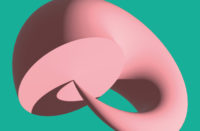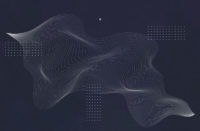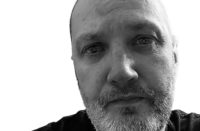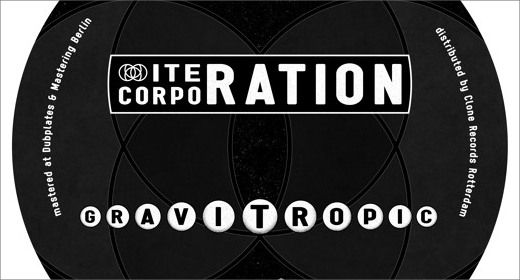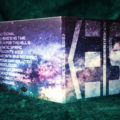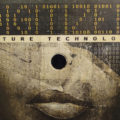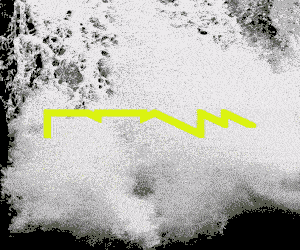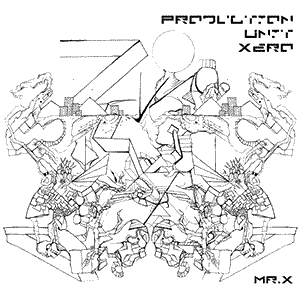THUMBTACK SMOOTHIE (a.k.a. Carl Coletti) made the strange transformation from studio session drummer (with bands like The Walkers, Ottmar Liebert and Luna Negra, and the Jason Newsted-led Godswallop) to experimental electronic musician. Besides a dizzying collection of solo work, he is also heavily involved in freaky San Francisco Bay Area hip-hop groups Pancake Circus and HE3. His new album Homestyle (Quake Trap, 2004) reflects an artist reaching towards the peak of his extremely weird powers. 7 years ago, he was a drummer who stumbled upon the (then) Metallica Bass-player’s portable sampler. Today he is easily one of San Francisco’s boldest sonic alchemists. Fellow Pancake Circus and Quake Trap Collective member Yoko Solo chats him up to find out what the hell happened…
::..:::…..:..::….:::::..:::..:::::::……:::…::.:::….::::..:..:::…::…….::::

Yoko Solo :: Let’s talk about this MS-1.
Carl Coletti / Thumbtack Smoothie :: During a dinner break from recording I asked Jason if I could screw around with his sampler and he said “sure!”. I recorded a bunch of coughing and other weird stuff and made this little song to bring in and play to the guys while they were eating. So I brought it in and played this out of my backpack speakers –I had a battery powered backpack with a subwoofer –so I played it and Jason started laughing, he said “God, if you had one of those, you’d be dangerous,” and I thought, “I want to be dangerous,” you know? We went back to playing and the sampler went back to his workbench thing and I couldn’t take my eyes off of it. I was amazed at how quickly I could take ideas and mold them into something with what I had with me –which was a good sense of rhythm. You could tap things in and sequence it real-time. So I finished those sessions and I came home one day and there was a message from a music store saying they had a package for me from Metallica’s road manager. They came by and dropped off a Roland MS-1 sampler with a note from Jason saying “Cheers, good luck, have fun.” It also came with this 10MB flashcard, you know what I mean? It came in this silver wrapper that I was scared to open up. I spent the next six hours developing a really stiff neck.
Yoko Solo :: So you were suddenly an electronic musician, I guess.
Carl Coletti :: It changed my way of thinking. At the time I was also making music in a band called Phunsighz with Shaggy Manatee using, like a Tascam 4 track down in his garage and then running vocals through my Aiwa boombox’s “Karaoke” function.
Yoko Solo :: What kind of music was this?
Carl Coletti :: We were influenced by Ween and Beck, real low-tech, borrowing people’s effects pedals –and when we added this MS-1 to the equation it kind of opened up a whole new door. It became a serious catalyst and it really shifted my attention from just drumming. I started asking engineers “What’s this, what’s that do?” and reading their audio magazines, listening to the sound guys talk to each other in a different way. I remember one day riding in the tour bus with Ottmar’s crew and saying something about non-destructive editing –I think I was asking these guys what they thought about one of those audio workstations –and somebody said jokingly, “Oooh, non-destructive editing! That’s a pretty big word for a drummer.” That little sampler started the shift from being a drummer playing in a band to being able to develop a musical vocabulary. What I’d developed playing with other people, I could now orchestrate on my own. At the time I was listening to a lot of cut-and-paste, collage records –Dust Brothers, A Tribe Called Quest, Gang Starr –and then my pump was really primed for what I thought it was all about when DJ Shadow put out Endtroducing.
Yoko Solo :: At this time you started recording your first solo LP, Full Term Pachiderm, a bumpy, bouncy, raw, funny album that sounded very much like straight ahead hip-hop. Meanwhile, you were laying down drum tracks and touring with Otmar Leibert in what were pretty pristine environments. What was it like to lay down a whole album of MS-1 to DAT while simultaneously working in that whole other studio realm?
Carl Coletti :: I was crossing those thresholds to those two worlds on a daily basis. While everyone else was down drinking in the hotel bar, I was in my room setting up my MS-1 and Ottmar’s portable DAT in the bathroom. It had power, I could sit backwards on the toilet, I put fresh towels all over it, and that was my desk.
Yoko Solo :: The toilet?
Carl Coletti :: I sat on the lid and everything was on the tank –I’d clean up all the water in the place so I wouldn’t get electrocuted. I was sharing a room so it was the only place I could get privacy for any extended period of time. The next minute I’m playing these pretty big venues with state of the art sound systems, highly paid engineers running around, we had in-ear monitors –and the records we were making at the time were recorded in really nice studios with a lot of attention to detail. My studio was in my backpack. I had a shortwave radio, a handheld tape deck, the MS-1, DAT, and a CD player. It was almost like an antidote for all the high-end stuff. It was nice to pound out un-editable performances and work with ideas on the spot.
Yoko Solo :: This sort of went against your previous experiences as well recording with Mike Denneen and John Lupfer in The Walkers. There was a very expensive and overblown recording session, right?
Carl Coletti :: A half million dollars was spent –it got to a point where we were cutting holes in drum risers to allow for a snare on top of another snare that would have been up by my chin were it not below the drum riser. At that point I was really interested in getting my drum performances down and in the interplay between the bass player, Micro Vard, and I. I had made records before in Boston with other people and done lots of studio work with other people, but things were intensified as we had a very serious producer in Kevin Killen. I was into getting the drums done and then going and reading a drum magazine, riding my bike around Lake Champlain, calling my girlfriend to fight about how i was going to be two weeks late coming home –that was what I was doing then. I didn’t even know what a compressor was. I probably should have spent more time paying attention and learning more but, quite honestly, when I was done recording my drums I just wanted to get the fuck out of there. Now you can’t get me away from the gear and my drums are sitting idol in the garage.
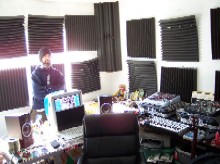
Yoko Solo :: Math Is Hard is an extreme recording. It literally pummels the brain. You know I love it, but I want to talk a bit about how I get feelings of dread while listening to it. It’s like the feeling you get in the middle of the night when you are worried about something. What spawned this stuff?
Carl Coletti :: It was a combination of a bunch of elements. I became addicted to making these crazy little audio fabrige egg dioramas that had a lot of detail in them and a lot of sonic confrontation. Once I started recording things into something where you could actually view a wave form, once I could see what the sound looked like, I started zooming in and really tried to push the envelope of what a speaker cone could take in, audio events that may have only happened for five milliseconds. When you start getting into a delay that lasts for only five milliseconds you’re getting into notes and scales and things –like when you hear notes while doing a digital scrub –suddenly you start to hear the relative pitch between what an effect did relative to a fairly innocuous sound source. Could have been a snare drum. A lot of times it was a digital pop. You start to hear 5ths and 3rds, these tonal relationships between all of these things, and songs start to take months to make. I kept going back and zooming in on these things that may have taken only a second or less to occur and would push these little audio bits –some of them becoming audio mistakes that I could then rework –pushing them to the limit of the digital red.
On top of this, I had just gotten Reactor and was using this in conjunction with my Roland SP-808, which is like a sampler and an audio workstation. I had that thing hooked up to my computer (Mac G3) and was bouncing ideas back and forth. I would work out little arrangements on the SP-808 and then scoot them back into the computer, edit them some more, and put them back into the sampler so I could have something malleable to touch. I was making a lot of aggressive sound, which makes sense now. The world was becoming a pretty confrontational place. There was so much hysteria underneath the surface of things that I had to maybe respond to how aggressive the world was gotten. I wanted to make some really hellacious noise that wouldn’t hurt anybody but had the goal of destruction. I think that between the beats, melody and audio events, that record was defined by the melodies that emerged from signal processing. The sounds used in the songs are the defining elements; the sounds kind of took over. I found myself expounding upon the things that made me the most uncomfortable. I’ve heard my record described as hermetic, paranoid, it sickens some people –it delights others. Most people run screaming from Math is Hard, but the people who get it, get it.
Yoko Solo :: It’s relentless. Even when it’s peaceful or gentle, you get sort of trained to expect, be concerned about, the next bludgeoning.
Carl Coletti :: I agree. Those little sounds definitely developed a life of their own and started to run amok in the compositions.
Yoko Solo :: You, in my very humble opinion, manage to squeak the very most out of what you have here, gear-wise. Were you running the same sort of set-up and following the same sort of process recording your new album, Homestyle, as you did in Math is Hard?
Carl Coletti :: Yes.
Yoko Solo :: Could you walk me through the recording of a track?
Carl Coletti :: It could start in a lot of different ways. Sometimes it’s a sample that I’ll chop up, and in chopping it up I’ll find new things that will spurn me on to something else. I’ll let what develops from there tell me where the bass line should be –sometimes I’ll start with a bass line, or maybe a weird, washy sound or something. Either way, I’ll build off that and search for the rhythmic pulse. I usually will add drums or percussive stuff last by punching it in real time from the sampler.
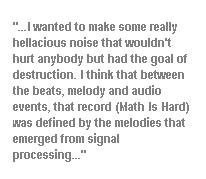
A lot of times I’ll make something using Reactor or running any type of sound through filters, plug-ins, and I’ll focus in on the things that shine the brightest. I’ll snatch those things from maybe ten minutes of stuff and trash the other nine. I’ll keep hacking away at that thing until it starts to shape itself into a piece –a verse, an intro –and then I try to develop the parts and give them structure. I love to use this great freeware program called Virtual Drummer that is basically a cheesy-sounding drum machine that’s really dry. You can just draw in the hits step-style so you can play around with those 64th note trills and stuff. Once I’ve filtered and re-filtered the original sound, the new thing begins to emerge. Melody and bass lines aren’t usually from traditional sources or any programs or samples that emulate bass or other instruments. I like to find melodic elements and isolate them, dump them into my sampler and then play them real-time along with the track. I just keep building this way, hacking it down, resorting everything.
Yoko Solo :: You have two SP-808s?
Carl Coletti :: One’s the EX with a 250MB zip drive and I have the 100MB original –they have 64 banks for samples and a little 8-track recorder. My favorite thing is the D-beam controller, which allows me to bypass some of the controller issues people have with a mouse or MIDI. I do a lot of my performances with it set to control the effects parameters so that can use my hand movements to disturb an infrared beam of light instead of two hands on three knobs or whatever –depending on whether you’re on the left, right side, high or low, those are all different zones. You can set those zones to effects parameters like delay return or effects levels or regeneration on something, filtering something –so you start to play it like a Theremin and begin to develop a good sense of control that I think lets you do things you wouldn’t be able to do as nicely real time were you trying to get a bunch of hands on knobs. It’s great for live performances, too.
Yoko Solo :: Do you do any sequencing?
Carl Coletti :: I like to play things rather than sequence it all up. I’m a drummer –so, I’ll piece things together and usually play them as if I’m the sequencer. It allows me a lot more elastic performances and let’s me interact real time without getting bogged down in the editing part of it. I like to play a part, go back a day later and then edit that down. Nothing is every locked up to a sequencer other than my sense of what my time is as a drummer. Sometimes the coolest thing happens when you hit it on the “and” of three or the “and” of seven. You can flip it around like that and interesting things that normally wouldn’t happen if you were to try to lock it down to an audio editor. Sometimes it’s a pain in the ass for me to even try and figure out how to do things like that –so I’ve developed this idiot-savant way of working where I build pieces, juggle them up in the air, and try to get them to land where I want them to land.
Yoko Solo :: Electrickitchentableland and Math is Hard were both recorded, literally, in a kitchen using mostly the same gear. How did you end up with such dramatically different albums?
Carl Coletti :: Every time my wife or I would make pasta, we had to open all the windows — “Condensation on the windows, condensation on the hard drive!” That was my mantra. My set-up initially was the Roland MS-1, a DAT player, a turntable, a little Vestax mixer, the first Roland SP-808 sampler, and the Mac G3 that I’m still running now. Electrickitchentableland was done almost exclusively through SP-808 performances and not much computer work, other than using it as a tape deck. I was still trying to figure out E-mail at that point, I didn’t know anything. I also was using traditional elements like drums, bass lines and sounds that remained in their original form more or less. Math is Hard was the point where I kind of got sucked into the computer and it wouldn’t let me out. I was using the same amount of gear but I was treating the output of that gear very differently. 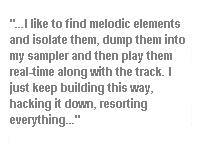 Instead of doing passes at each track, overdubs, until it was done, I started thinking, “OK, I just recorded a track, now time to filter it and see what happens –or randomize that minute there and extract a piece of the melody that emerges –or let’s take that bass line and shift the left channel up an octave and the right down an octave.” It became more about giving each element in the mix a chance to run amok with the signal processing but trying to keep it harnessed to the composition. That harness could be a drum beat or whatever.
Instead of doing passes at each track, overdubs, until it was done, I started thinking, “OK, I just recorded a track, now time to filter it and see what happens –or randomize that minute there and extract a piece of the melody that emerges –or let’s take that bass line and shift the left channel up an octave and the right down an octave.” It became more about giving each element in the mix a chance to run amok with the signal processing but trying to keep it harnessed to the composition. That harness could be a drum beat or whatever.
I also got really into having the elements take turns doing each other’s jobs. A hi-hat part may be the melody line, the bass line may be the drum line, or the filtering of the drum-line acts as the melody. Math is Hard gets pretty crazy but, if you listen to it another way, it’s not that crazy. It’s almost like hip-hop production in a way with the beats being pretty raw. It can get complex but a lot of the time I was just trying to slam you over the head.
::..:::…..:..::….:::::..:::..:::::::……:::…::.:::….::::..:..:::…::…….::::
Do you want to ask Thumbtack Smoothie how to deconstruct a millisecond of audio or contact sentient otherworld entities? It’s easy! Just email him at [email protected]!
::..:::…..:..::….:::::..:::..:::::::……:::…::.:::….::::..:..:::…::…….::::
Original interview published at Quake Trap website.






